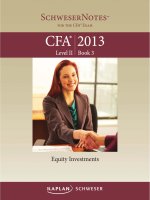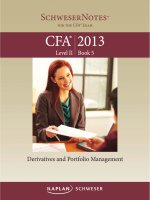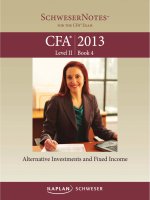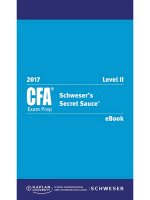2018 CFA level 2 quicksheet
Bạn đang xem bản rút gọn của tài liệu. Xem và tải ngay bản đầy đủ của tài liệu tại đây (572 KB, 6 trang )
LEVEL II SCHWESER'
C r it ic a l C o n c e pt s
ETHICALAND PROFESSIONAL
STANDARDS
I
Professionalism
I (A) Knowledge of the Law
I (B) Independence and Objectivity
I (C )
I (D)
II
II (A)
II (B)
III
HI (A)
HI (B)
HI (C)
HI (D)
HI (E)
IV
IV (A)
IV (B)
IV (C)
V
v (A)
V (B)
V (C)
VI
VI (A)
VI (B)
VI (C)
VII
VII (A)
VII (B)
Misrepresentation
Misconduct
Integrity o f Capital Markets
Material Nonpublic Information
Market Manipulation
Duties to Clients
Loyalty, Prudence, and Care
Fair Dealing
Suitability
Performance Presentation
Preservation of Confidentiality
Duties to Employers
Loyalty
Additional Compensation Arrangements
Responsibilities o f Supervisors
Investment Analysis, Recommendations,
and Action
Diligence and Reasonable Basis
Communication with Clients and
Prospective Clients
Record Retention
Conflicts o f Interest
Disclosure o f Conflicts
Priority of Transactions
Referral Fees
Responsibilities as a CFA Institute
Member or CFA Candidate
Conduct in the CFA Program
Reference to CFA Institute, CFA
Designation, and CFA Program
QUANTITATIVEMETHODS
Simple Linear Regression
Correlation:
covXY
rXY =
( s x )( s y )
t-test for r (n - 2 d f): t =
rVn —2
Estimated slope coefficient:
cov xy
Estimated intercept: b0 = Y —bjX
Confidence interval for predicted Y-value:
2018
fo r t h e
C FA ®
Standard error of estimate (SEE = VM SE ).
Smaller SEE means better fit.
• Coefficient of determination (R2 = RSS / SST).
% of variability of Y explained by Xs; higher R2
means better fit.
Regression Analysis— Problem s
• Heteroskedasticity. Non-constant error variance.
Detect with Breusch-Pagan test. Correct with
White-corrected standard errors.
• Autocorrelation. Correlation among error
terms. Detect with Durbin-Watson test; positive
autocorrelation if D W < d(. Correct by adjusting
standard errors using Hansen method.
• Multicollinearity. High correlation among Xs.
Detect if F-test significant, t-tests insignificant.
Correct by dropping X variables.
M ultiple Regression
Yi = b0 +( b 1x X li) + (b2 x X 2l)
+ (b3 X X 3i) + £;
• Omitting a variable.
• Variable should be transformed.
• Incorrectly pooling data.
• Using lagged dependent vbl. as independent vbl.
A
• Measuring independent variables with error.
Effects o f M isspecification
Regression coefficients are biased and inconsistent,
lack o f confidence in hypothesis tests o f the
coefficients or in the model predictions.
Linear trend model: yt = b0 + b,t + £t
Log-linear trend model: ln(yt ) = b0 + b,t + £t
Covariance stationary: mean and variance don’t
change over time. To determine if a time series is
covariance stationary, (1) plot data, (2) run an AR
model and test correlations, and/or (3) perform
Dickey Fuller test.
Unit root: coefficient on lagged dep. vbl. = 1. Series
with unit root is not covariance stationary. First
differencing will often eliminate the unit root.
Autoregressive (AR) model: specified correctly if
autocorrelation o f residuals not significant.
Mean reverting level for A R(1):
bo
(1 — b j)
RM SE: square root o f average squared error.
Random W alk T im e Series:
xt = xt-i + £t
Seasonality: indicated by statistically significant
lagged err. term. Correct by adding lagged term.
ARCH: detected by estimating:
= ao + ai^t-i + Bt
/
, n —k —1 df
Variance o f ARCH series:
A2
Reject if |t| > critical t or p-value < a .
Confidence Interval: bj ± |tc X sg
SST = RSS + SSE.
M SR = RSS / k.
M SE = SSE / ( n - k - 1).
Test statistical significance o f regression:
F = M SR / M SE with k and n —k — 1 df (1-tail)
A
X
vC, bid
B , bid
'A '
/A X
vC, offer
\ B , offer
VC
^ /bid
/ T-x \
B
X
\C
^ /offer
Currency arbitrage: “Up the bid and down the ask.”
Forward premium = (forward price) - (spot price)
Value o f fwd currency contract prior to expiration:
Vt =
(FPt — FP)(contract size)
\
days
1+ RA
360
Covered interest rate parity:
Uncovered interest rate parity:
e
• Forecasting the past.
• Test statistical significance o f b; H (): b = 0,
t= y
ECONOMICS
bid-ask spread = ask quote - bid quote
Cross rates with bid-ask spreads:
n>
.B
'A '
'A '
days
1+ R a
•0
360 /
F = ^ -------days
1+ R B
360
M odel M isspecification
A
Y ± tc x SE of forecast
E xa m
(% a s w , = R , - K
Fisher relation:
R nominal = R real. + E(inflation)
International Fisher Relation:
R nominal
. A —R nominal
. B = E(inflation.)
v
A'
E(inflationB)
Relative Purchasing Power Parity: High inflation
rates leads to currency depreciation.
%AS(A/B) = inflation Xj - inflation,B)
where: % AS(A/B) = change in spot price (A/B)
Profit on FX Carry Trade = interest differential change in the spot rate of investment currency.
Mundell-Fleming model: Impact o f monetary
and fiscal policies on interest rates & exchange
rates. Under high capital mobility, expansionary
monetary policy/restrictive fiscal policy —>low
interest rates —> currency depreciation. Under low
capital mobility, expansionary monetary policy/
expansionary fiscal policy —> current account
deficits —» currency depreciation.
Dornbusch overshooting model: Restrictive
monetary policy —» short-term appreciation of
currency, then slow depreciation to PPP value.
Labor Productivity:
output per worker Y/L = T(K/L)‘'
Growth Accounting:
growth rate in potential GDP
= long-term growth rate of technology
+ a (long-term growth rate o f capital)
+ (1 - a) (long-term growth rate of labor)
growth rate in potential GDP
= long-term growth rate of labor force
+ long-term growth rate in labor productivity
Classical Growth T heory
• Real GDP/person reverts to subsistence level.
A A2
CTt+l = a0 + al£t
Risk Types:
Appropriate
m ethod
Distribution
o f risk
Sequential?
Accommodates
Correlated Variables'
Simulations
Continuous
Does not
matter
Yes
Scenario
analysis
Discrete
No
Yes
Decision trees
Discrete
Yes
No
Neoclassical Growth T heory
• Sustainable growth rate is a function of
population growth, labor’s share o f income, and
the rate of technological advancement.
• Growth rate in labor productivity driven only by
improvement in technology.









